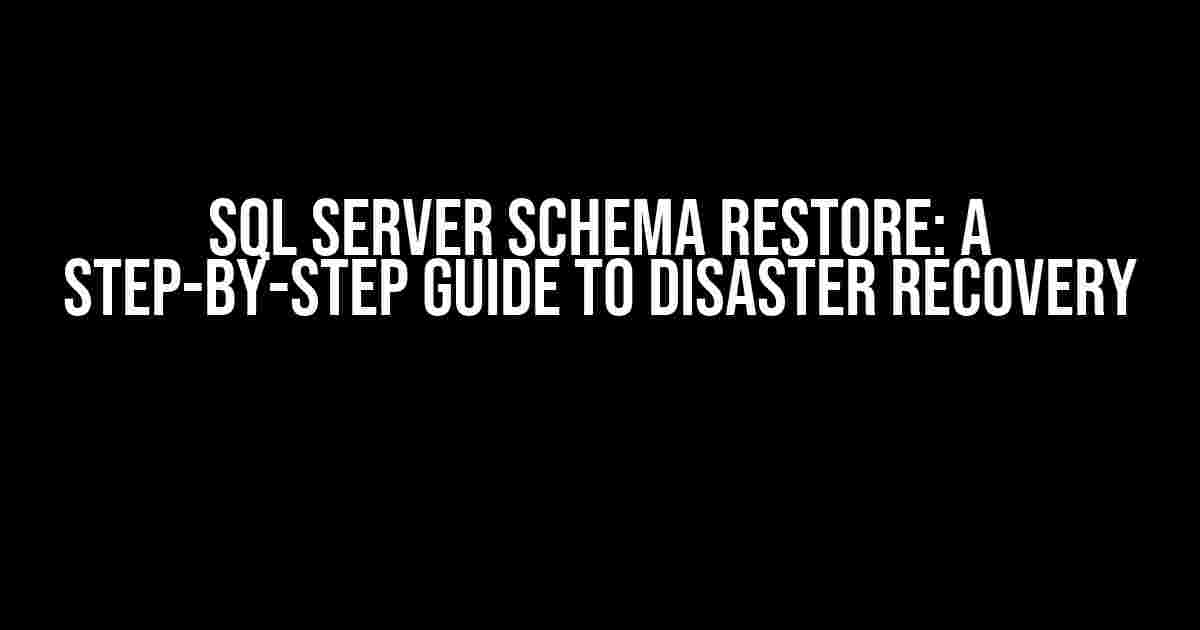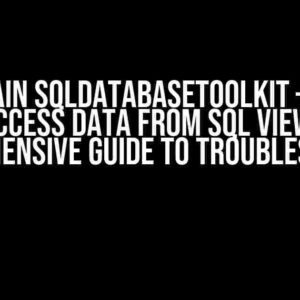Imagine waking up one morning to find that your SQL Server database has gone haywire. Maybe someone accidentally dropped a crucial table, or a malicious attack compromised your database’s integrity. Whatever the reason, you’re left staring at a blank screen, wondering how to get your database back online. Fear not, dear reader, for we have a solution – SQL Server schema restore!
What is SQL Server Schema Restore?
A SQL Server schema restore is a process that allows you to recover your database’s structure and organization, including tables, views, stored procedures, and other objects. This is different from a data restore, which focuses on retrieving data that has been lost or corrupted. Schema restore is essential when you need to reconstruct your database’s layout and ensure that all objects are intact and functioning correctly.
When to Perform a SQL Server Schema Restore
-
When a database object (e.g., table, view, stored procedure) is accidentally dropped or modified.
-
After a database migration or upgrade goes awry.
-
When a database administrator makes unintended changes to the schema.
-
As part of a regular disaster recovery plan to ensure business continuity.
Preparation is Key: Gathering Necessary Files and Information
Before you begin the SQL Server schema restore process, you’ll need to gather some essential files and information. Make sure you have:
-
A valid backup of your database schema (more on this later).
-
The target server’s SQL Server instance and database name.
-
Administrative privileges on the target server.
-
A clear understanding of your database’s schema and object dependencies.
Backing Up Your SQL Server Schema
To perform a successful schema restore, you’ll need a reliable backup of your database schema. You can create a schema backup using SQL Server Management Studio (SSMS) or via T-SQL commands.
-- T-SQL command to generate a schema-only backup
BACKUP DATABASE [database_name] TO DISK = 'C:\Backup\schema_backup.bak' WITH FORMAT, NO_COMPRESSION, STATS = 10, NAME = N'Schema Backup';
Step-by-Step SQL Server Schema Restore Process
Now that you have your schema backup and necessary information, it’s time to initiate the restore process. Follow these steps carefully to ensure a successful recovery:
-
Connect to the target server: Open SSMS and connect to the target server using administrative credentials.
-
Create a new database: Create a new database on the target server, which will serve as the restored database. Give it a unique name to avoid conflicts with the original database.
-
Restore the schema backup: Right-click the new database in SSMS and select “Tasks” > “Restore” > “Database…”.
-
Select the backup file: In the “Restore Database” window, select “Device” as the source and click “Browse” to locate your schema backup file (e.g., schema_backup.bak).
-
Restore options: In the “Options” tab, select “Restore” and choose the “Schema only” option. This will restore only the database schema, excluding data.
-
Verify the restore: Click “OK” to initiate the restore process. Monitor the progress and verify that the schema has been successfully restored.
Troubleshooting Common Issues
During the restore process, you might encounter some common issues. Here’s how to troubleshoot them:
| Error Message | Solution |
|---|---|
| “Error 3241: The media family on device ‘C:\Backup\schema_backup.bak’ is incorrectly formed.” | Verify that the backup file is not corrupted and try restoring from a different location. |
| “Error 5133: The database is already open and can only be restored from a backup.” | Close any active connections to the database and try restoring again. |
| “Error 3013: The database is not a valid Microsoft SQL Server database.” | Verify that the backup file is a valid SQL Server schema backup and try restoring again. |
Conclusion
SQL Server schema restore is a powerful feature that can save your database from disaster. By following this step-by-step guide, you’ll be able to recover your database’s structure and organization in no time. Remember to:
- Regularly back up your database schema.
- Test your backups to ensure they’re valid and complete.
- Document your database’s schema and object dependencies.
- Practice disaster recovery scenarios to ensure business continuity.
With these best practices in place, you’ll be well-prepared to tackle any unexpected database issues that come your way. Happy restoring!
Note: This article is optimized for the keyword “SQL Server schema restore” and includes relevant meta information, header tags, and content structure to improve search engine optimization (SEO).
Frequently Asked Questions
Get the lowdown on SQL Server schema restore with these frequently asked questions!
What is SQL Server schema restore, and why is it important?
SQL Server schema restore is the process of recovering a database’s structure, including tables, views, stored procedures, and other objects, from a backup or snapshot. This is crucial in case of data loss, corruption, or accidental changes, ensuring business continuity and minimizing downtime.
What are the types of backup files used for SQL Server schema restore?
There are two primary types of backup files used for SQL Server schema restore: Full Backups (.bak) and Differential Backups (.dif). Full Backups contain the entire database, while Differential Backups store changes made since the last Full Backup. Additionally, Transaction Log Backups (.trn) are used to restore transaction log files.
Can I restore a SQL Server schema to a different server or instance?
Yes, you can restore a SQL Server schema to a different server or instance using the RESTORE command with the MOVE option. This allows you to relocate the database files and restore the schema to a new environment, making it ideal for migrations, upgrades, or development testing.
How do I ensure data consistency during a SQL Server schema restore?
To ensure data consistency, it’s essential to restore the database in a specific order: first, restore the database files, followed by the transaction log files. Then, apply any pending transactions from the transaction log files using the RECOVERY option. This ensures that the database is restored to a consistent state.
What are some best practices for SQL Server schema restore?
Key best practices for SQL Server schema restore include: regularly testing backups, using a consistent naming convention, documenting restore procedures, and verifying data integrity after restoration. Additionally, consider implementing a backup and restore strategy that includes automation, version control, and monitoring for optimal database management.





